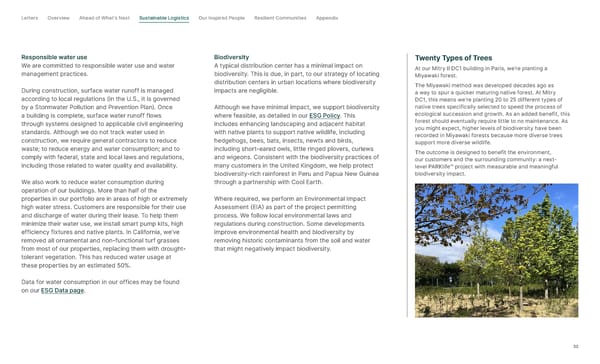Letter s Overview Ahead of What’s Next Sustainable Logistics Our Inspired People Resilient Communities Appendix Responsible water use Biodiversity Twenty Types of Trees We are committed to responsible water use and water A typical distribution center has a minimal impact on At our Mitry II DC1 building in Paris, we’re planting a management practices. biodiversity. This is due, in part, to our strategy of locating Miyawaki forest. distribution centers in urban locations where biodiversity The Miyawaki method was developed decades ago as During construction, surface water runoff is managed impacts are negligible. a way to spur a quicker maturing native forest. At Mitry according to local regulations (in the U.S., it is governed DC1, this means we’re planting 20 to 25 different types of by a Stormwater Pollution and Prevention Plan). Once Although we have minimal impact, we support biodiversity native trees specifically selected to speed the process of a building is complete, surface water runoff flows where feasible, as detailed in our ESG Policy . This ecological succession and growth. As an added benefit, this through systems designed to applicable civil engineering includes enhancing landscaping and adjacent habitat forest should eventually require little to no maintenance. As standards. Although we do not track water used in with native plants to support native wildlife, including you might expect, higher levels of biodiversity have been construction, we require general contractors to reduce hedgehogs, bees, bats, insects, newts and birds, recorded in Miyawaki forests because more diverse trees support more diverse wildlife. waste; to reduce energy and water consumption; and to including short-eared owls, little ringed plovers, curlews The outcome is designed to benefit the environment, comply with federal, state and local laws and regulations, and wigeons. Consistent with the biodiversity practices of our customers and the surrounding community: a next- including those related to water quality and availability. many customers in the United Kingdom, we help protect level PARKlife™ project with measurable and meaningful biodiversity-rich rainforest in Peru and Papua New Guinea biodiversity impact. We also work to reduce water consumption during through a partnership with Cool Earth. operation of our buildings. More than half of the properties in our portfolio are in areas of high or extremely Where required, we perform an Environmental Impact high water stress. Customers are responsible for their use Assessment (EIA) as part of the project permitting and discharge of water during their lease. To help them process. We follow local environmental laws and minimize their water use, we install smart pump kits, high regulations during construction. Some developments efficiency fixtures and native plants. In California, we’ve improve environmental health and biodiversity by removed all ornamental and non-functional turf grasses removing historic contaminants from the soil and water from most of our properties, replacing them with drought- that might negatively impact biodiversity. tolerant vegetation. This has reduced water usage at these properties by an estimated 50%. Data for water consumption in our offices may be found on our ESG Data page . 30
 2023-24 ESG Report Page 29 Page 31
2023-24 ESG Report Page 29 Page 31